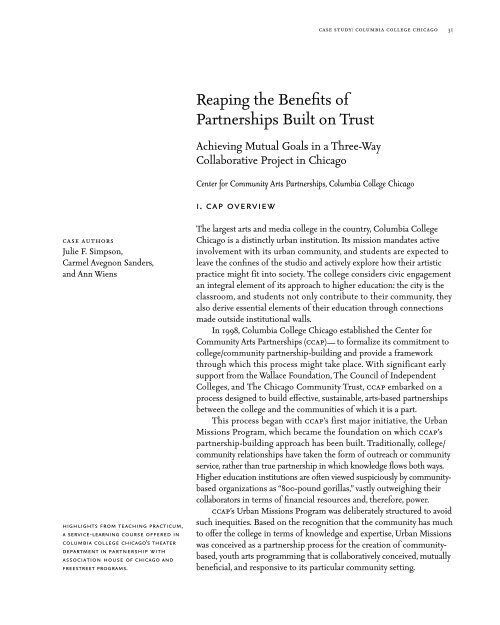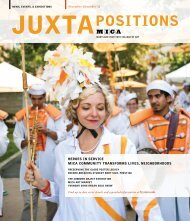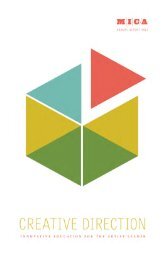art/vision/voice - Maryland Institute College of Art
art/vision/voice - Maryland Institute College of Art
art/vision/voice - Maryland Institute College of Art
Create successful ePaper yourself
Turn your PDF publications into a flip-book with our unique Google optimized e-Paper software.
case authors<br />
Julie F. Simpson,<br />
Carmel Avegnon Sanders,<br />
and Ann Wiens<br />
highlights from teaching practicum,<br />
a service-learning course <strong>of</strong>fered in<br />
columbia college chicago’s theater<br />
dep<strong>art</strong>ment in p<strong>art</strong>nership with<br />
association house <strong>of</strong> chicago and<br />
freestreet programs.<br />
Reaping the Benefits <strong>of</strong><br />
P<strong>art</strong>nerships Built on Trust<br />
Achieving Mutual Goals in a Three-Way<br />
Collaborative Project in Chicago<br />
Center for Community <strong>Art</strong>s P<strong>art</strong>nerships, Columbia <strong>College</strong> Chicago<br />
i. cap overview<br />
case study: columbia college chicago 31<br />
The largest <strong>art</strong>s and media college in the country, Columbia <strong>College</strong><br />
Chicago is a distinctly urban institution. Its mission mandates active<br />
involvement with its urban community, and students are expected to<br />
leave the confines <strong>of</strong> the studio and actively explore how their <strong>art</strong>istic<br />
practice might fit into society. The college considers civic engagement<br />
an integral element <strong>of</strong> its approach to higher education: the city is the<br />
classroom, and students not only contribute to their community, they<br />
also derive essential elements <strong>of</strong> their education through connections<br />
made outside institutional walls.<br />
In 1998, Columbia <strong>College</strong> Chicago established the Center for<br />
Community <strong>Art</strong>s P<strong>art</strong>nerships (ccap)— to formalize its commitment to<br />
college/community p<strong>art</strong>nership-building and provide a framework<br />
through which this process might take place. With significant early<br />
support from the Wallace Foundation, The Council <strong>of</strong> Independent<br />
<strong>College</strong>s, and The Chicago Community Trust, ccap embarked on a<br />
process designed to build effective, sustainable, <strong>art</strong>s-based p<strong>art</strong>nerships<br />
between the college and the communities <strong>of</strong> which it is a p<strong>art</strong>.<br />
This process began with ccap’s first major initiative, the Urban<br />
Missions Program, which became the foundation on which ccap’s<br />
p<strong>art</strong>nership-building approach has been built. Traditionally, college/<br />
community relationships have taken the form <strong>of</strong> outreach or community<br />
service, rather than true p<strong>art</strong>nership in which knowledge flows both ways.<br />
Higher education institutions are <strong>of</strong>ten viewed suspiciously by communitybased<br />
organizations as “800-pound gorillas,” vastly outweighing their<br />
collaborators in terms <strong>of</strong> financial resources and, therefore, power.<br />
ccap’s Urban Missions Program was deliberately structured to avoid<br />
such inequities. Based on the recognition that the community has much<br />
to <strong>of</strong>fer the college in terms <strong>of</strong> knowledge and expertise, Urban Missions<br />
was conceived as a p<strong>art</strong>nership process for the creation <strong>of</strong> communitybased,<br />
youth <strong>art</strong>s programming that is collaboratively conceived, mutually<br />
beneficial, and responsive to its p<strong>art</strong>icular community setting.
















